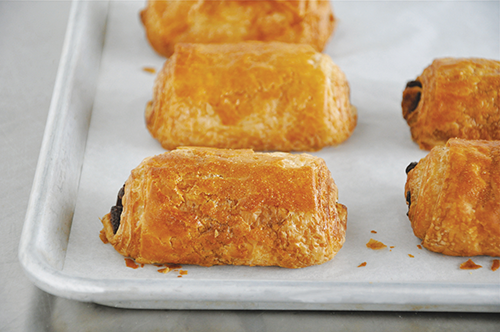Rich, flaky and the perfect complement to your morning cup of coffee, the croissant is the quintessential French pastry. But how did the croissant come to be?
To celebrate National Croissant Day, we’re taking a deep dive into the history of the croissant, complete with input from ICE’s Director of Pastry Research & Development, Chef Jürgen David.
Across various accounts of croissant history, most sources agree that it originates from Austria as the kipferl. Made from a yeasted wheat dough, the kipferl is a baked bread roll common in Central Europe. Records state that the kipferl has been around as early as the 13th century, but many believe it may be even older. Popular myths attribute its invention as a celebration of the Ottoman Empire’s defeat in the Battle of Vienna; the crescent shape represented the moon on the Ottoman flag.
“These stories are almost certainly untrue,” Austrian native Chef Jürgen says.
Regardless of the kipferl’s origins, it would migrate to France later in the 19th century.
In another common legend, Marie Antoinette is said to have introduced the kipferl to French court, homesick for foods from Austria. While it’s a romantic story, there are no historical records to back up this retelling.
The earliest recorded introduction of the kipferl to France occurred in 1839, when Austrian artillery officer August Zang founded a Viennese bakery in Paris. Parisians fell in love with the kipferl (and with Viennese baking as a whole), and imitated the bread in their own shops. The name "croissant" also began appearing in historical record, referring to the crescent shape of the bread.
In 1915, Sylvain Claudius Goy recorded the first-known French version of the croissant recipe. Instead of brioche dough, as August Zang used, Goy transformed the recipe to use a laminated yeast dough. Lamination involves folding butter and dough to create thin, flaky layers of pastry.
And thus, the iconic French pastry we know and love today was born.

Most of us today are familiar with frozen croissants, accessible at grocery stores, bakeries and restaurants. They're a relatively new invention born of innovation.
As technology modernized, the Sara Lee corporation in America pioneered a method to freeze croissant dough for shipping in 1981. The frozen dough only needed to be quickly baked before serving. This allowed businesses to employ unskilled labor and for people to make croissants at home with ease.
Through its many evolutions, food experts and historians agree that the croissant has become a uniquely French pastry. The French government even named it as the national French product in 1920.
Many other countries also have their own spin-offs of the croissant. From Spain’s cream-filled Xuixo to the American fast-food croissan’wich, it’s truly a staple of modern global cuisine.
Chef Jürgen, who learned pastry arts in Vienna, Austria, is a croissant connoisseur.
“When I worked in Switzerland, my job was to roll the croissants in the morning and it was the best thing,” he says. “I’m a big fan of anything laminated. There aren't any special tricks, and it’s fun to roll out all the layers.”
His favorite is a good old-fashioned curved croissant, plain and simple. As he puts it: “I just love making — and eating — croissants.”





